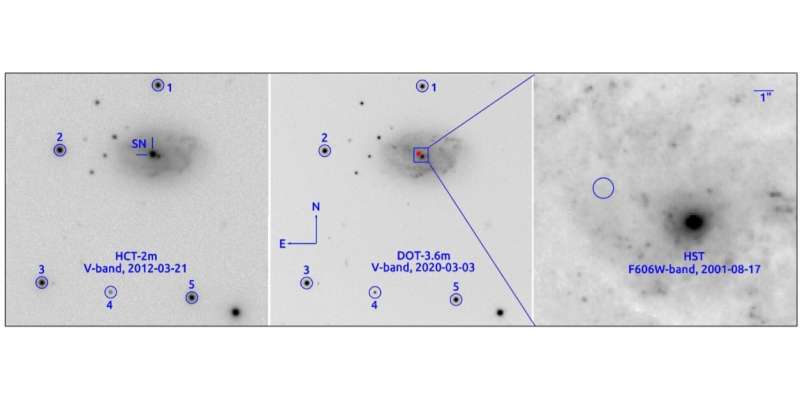July 7, 2021 report
Researchers examine properties of supernova SN 2012au

An international team of astronomers has performed photometric, polarimetric and spectroscopic observations of the Type Ib supernova SN 2012au. Results of this comprehensive study deliver important information regarding the properties of this cosmic explosion. The research was detailed in a paper published June 30 on the arXiv pre-print server.
Type Ib supernovae (SNe Ib) are a subclass of stripped-envelope core-collapse SNe. They are formed when a massive star, with its outer envelope of hydrogen stripped away, collapses under its own gravity. SNe Ib could be crucial to improve our understanding of the evolution of massive stars, post-explosion interaction, and properties of resulting supernovae.
SN 2012au was discovered by Catalina Real-Time Transient Survey SNHunt project on March 14, 2012 in the galaxy NGC 4790 located some 77 million light years away. Based on the subsequent observations, SN 2012au has been classified as an SN Ib.
In order to shed more light on the nature of SN 2012au, a team of astronomers led by Shashi Bhushan Pandey of the Aryabhatta Research Institute of Observational Sciences in India, decided to conduct optical photometric, polarimetric and optical, near-infrared spectroscopic observations of this supernova. For this purpose, they used various ground-based facilities worldwide, including India's Sampurnanand Telescope, Devasthal Fast Optical Telescope, and Himalayan Chandra Telescope.
"In this study, we present the well-calibrated photometric, polarimetric, and spectroscopic studies of SN 2012au spanning from 5 days before B-band maximum to nearly one year post-maximum," the researchers wrote in the paper.
In general, the study found that SN 2012au is one of the most luminous slow-decaying Type Ib SNe. It has an absolute peak magnitude of -18.06 mag and −18.67 mag in the B-band and R-band, respectively. The absolute peak magnitude in the R-band for SN 2012au appears to be brighter in comparison to the mean value calculated for SNe Ib and Ic.
Furthermore, the spectral evolution of SN 2012au is similar to other typical SNe Ib. However, The spectral comparison reveals that photometrically slow-decaying SN 2012au also evolves slower spectroscopically.
The ejecta mass for SN 2012au was calculated to be between 4.7 and 8.3 solar masses, while its kinetic energy was estimated to be at a level of 4.8-5.4 sexdecillion erg. These values are higher in comparison to most Sne of Type IIb, Ib, and Ic.
The research also found that SN 2012au exhibits the most shallower post-peak decay rate in comparison to those of Type Ib and slow-decaying superluminous SNe. This may indicate high trapping of gamma-rays or higher opacity of the massive ejecta.
When it comes to the progenitor of SN 2012au, the authors of the paper assume that it is a single Wolf-Rayet star, with oxygen, helium-core, and main sequence masses estimated to be 1.62, 4–8, and 17–25 solar masses, respectively.
More information: Photometric, polarimetric, and spectroscopic studies of the luminous, slow-decaying Type Ib SN 2012au, arXiv:2106.15856 [astro-ph.HE] arxiv.org/abs/2106.15856
© 2021 Science X Network


















